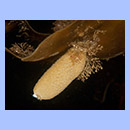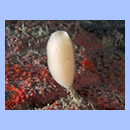- Kingdom: Animalia
- Phylum: Porifera
- Norwegian: svamper
Characteristics:
Sponges extract nutrition from water pumped through the body. A sponge may filter 10.000 - 20.000 times its own volume every day. Tiny hairs shimmer continuously to pump water through its internals. Sponges do not have a mouth, a neural system or even any sensing organs. However, they have a variety of specialized cells:
- Collar cells build the sponge's digestive system.
- Tubular cells give structure to the pores and pump water through the channels.
- Epidermal cells form the sponge's outer skin.
- Other cells perform vital functions like transport of nutrition and production of gametes for sexual reproduction.
All though most sponges are hermaphrodites (reproduce as both sexes) asexual reproduction by fragmentation is very common as well. Sponges are responsible for the very important task of dissolving solid calcium and thereby enable mussels and others to reuse it to build their shells.

